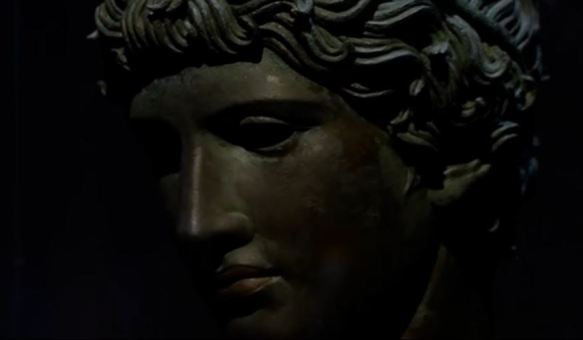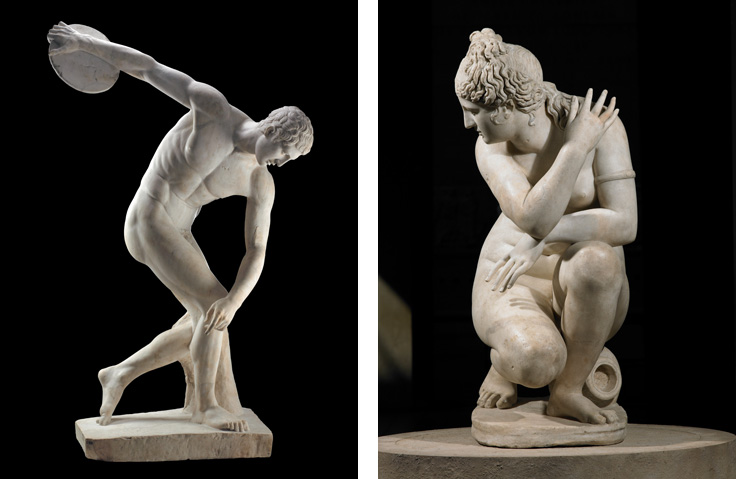Giacobbe Giusti: Bronze Sculpture of the Hellenistic World

by Mike Boehm Los Angeles Times
Here’s a paradox: Today’s art lovers would recoil at the thought of travel disasters, building collapses or volcanic eruptions afflicting their own communities. But over the next three months, visitors to the Getty Museum can enjoy a unique display of bronze statuary that was saved for posterity precisely because such calamities befell its ancient owners.
The show is “Power and Pathos: Bronze Sculpture of the Hellenistic World,” running Tuesday to Nov. 1 at the Getty Center in Brentwood — an atypical venue for an ancient-art show, which normally would be seen at the Getty Villa in Pacific Palisades.
ADVERTISEMENT
The two Getty curators who spent seven years organizing “Power and Pathos” say the 46 rare bronzes in the show needed to be seen in the best light and from all angles. The special exhibitions galleries in Brentwood afford space and natural lighting that the Villa lacks.
Essential Arts & Culture: A curated look at SoCal’s wonderfully vast and complex arts world
Having spent up to 2,300 years buried far below the ground or sunken in ocean beds of the Mediterranean Sea, this is art that deserves a deluxe presentation, given all it has been through.
What’s most special about the exhibition, curators Jens Daehner and Kenneth Lapatin say, is that it’s the first to bring together so many prized and exceedingly rare works of its period and kind.
lFull Coverage
Gallery and museum reviews: Full coverage
Gallery and museum reviews: Full coverage
For scholars it’s an unprecedented opportunity to eyeball one-fourth of the world’s known Hellenistic bronzes in one place, comparing and contrasting and perhaps leading to new understanding of how these works were created and what they meant to their ancient public.
For museum-goers, “Power and Pathos” is a chance to get a good sense of the complex currents that influenced creativity between the golden age of Greece, which historians call the “classical” period, and the dawn of the Roman Empire. The seeds of today’s conceptions about what art is for were planted in the Hellenistic world, as a burgeoning nonroyal upper class formed history’s first art market and began to commission works reflecting themselves rather than their rulers and their gods.
“All of what we have survived by chance, and we’re lucky to have it. How many more statues are under the sea bed or underground waiting to be pulled up, we don’t know.
— Kenneth Lapatin, curator
The Hellenistic period spans nearly 300 years, from the death of Alexander the Great in 323 BC to Augustus Caesar’s triumph over Cleopatra and Mark Antony in 31 BC. The Egyptian queen was the last descendant of Ptolemy, one of the generals who had divided Alexander’s empire, which sprawled from Greece to what’s now Pakistan.
With a few exceptions, the statues on display were lost for centuries. Some were excavated starting in the 1700s from sites such as Herculaneum in Italy, which perished along with Pompeii in the eruption of Mt. Vesuvius in A.D. 79. Many were pulled from coastal waters off Italy, Greece, Croatia, Tunisia and Turkey, where ancient cargo ships had been scuttled by pirates or wrecked by storms. One star attraction, a bronze sculpture of a seated boxer with bandaged hands and a battered, broken-nosed face and cauliflower ears, was placed in a deep pit at the bottom of an ancient wall in Rome for reasons that remain a mystery.
“All of what we have survived by chance, and we’re lucky to have it,” said Lapatin, whose vertical shock of hair makes him the Lyle Lovett of antiquarians. “How many more statues are under the sea bed or underground waiting to be pulled up, we don’t know. They were ubiquitous in antiquity, but they are rare today.”
Bronze was valuable and easily repurposed for myriad practical uses, so statues made of the metal became antiquity’s equivalent of the passenger pigeon — except for about 200 known exceptions. “You also had ideological reasons” for their wholesale destruction, Lapatin said. “Early Christians weren’t interested in preserving nude statues of pagan gods, and this was ready cash.”
That disaster kept a precious few bronzes from destruction “is the utter paradox” that underlies the show, said Daehner, an affable, soft-spoken German. “You could call it the paradox of archaeology in general, but for bronze it’s particularly true and poignant.”
Silver lining
The show is itself a silver lining of sorts. It had its genesis in the 2007 settlement of the Italian government’s grievances over looted ancient artworks the Getty had acquired, in which the museum returned 40 suspect pieces to Italy, including some of its most prized holdings. But with the return of comity and cooperation, Getty curators could now approach the great museums of Italy with ideas for art loans and collaboration on exhibitions. In 2008 the Getty entered a pact for art exchanges with the National Archaeological Museum in Florence.
Looking for intersections between the collections, curators noted that each sported magnificent Hellenistic bronzes — among them the “Getty Bronze,” a famous statue of a young athlete that was netted from the Aegean Sea by Italian fisherman, and the “Herm of Dionysos,” a Getty-owned example of one of the quirkiest forms of ancient art.
From there, they approached dozens of other museums, landing loans from 30 institutions in 12 countries — among them the Metropolitan Museum, the Smithsonian Institution, British Museum, the Prado and the Louvre.
“Many are national treasures or highlights of a museum,” Lapatin said. That so many pitched in — often with works never seen before in the United States — shows how strong the exhibition’s allure has been for scholars of ancient art. “It’s a testament to bringing them out of splendid isolation to [the Getty], where they’re talking to each other. No one has ever done this before.”
Today’s international politics kept a few desired sculptures out of reach. “There are pieces in Baghdad and Tehran that would have been very interesting to have in the show,” Daehner said. “In 2008 the world looked very different than it is now,” and getting them momentarily had seemed possible.
The display of the Getty’s two prime Hellenistic bronzes embodies the quest for consonance, comparison and contrast that Daehner and Lapatin were after. Viewers will get a simultaneous glimpse of the life-size “Getty Bronze,” which usually occupies a room of its own at the Villa, alongside similar works from the British Museum and the Museum of Underwater Antiquities in Athens. Together, Daehner said, they reflect the Hellenistic convention of idealizing the human body, yet making it more accessibly natural than would have been the case in the 400s BC and earlier.
Herms were boundary markers with a sculpted head at the top of a narrow pedestal and male genitalia poking out farther down. The genre gets its name from the god Hermes, whose head frequently topped the markers. The Getty’s herm shows a head of the god Dionysos, its hat and beard calling to mind portraits of the English King Henry VIII. To its right stands a near doppelganger fetched from coastal waters of Tunisia.
Were they made by the same sculptor or workshop? If so, why is the coloration so different, and why does the Tunisian herm have subtle, intricate touches — such as a fully detailed head of hair on the back of his scalp — that the Getty version is missing?
ADVERTISEMENT
The word “pathos” in the show’s title reflects the objects’ lost-and-found history of past tragedy as well as Hellenistic sculptors’ key aesthetic breakthrough — using bronze, which is more pliable than marble, to register in acute detail the often careworn lives of mere mortals after centuries in which the main purpose of statuary was to capture the otherworldly majesty of gods and heroes.
A gallery devoted to depictions of ordinary humans rather than gods or rulers shows how Hellenistic sculptors began to embody common feelings. The face of a large “Portrait Statue of a Boy,” dug from the sands on the island of Crete, wears a look that projects sneering disgust mixed with an aching throb of sadness. The angsty defiance of adolescents apparently predates Holden Caulfield and Kurt Cobain by two millennia.
“Our modern idea of capturing character or personality is something that happens in the Hellenistic age that isn’t there before,” Daehner said. “Expression, emotion and a certain psychological realism get into a portrait.”
The Hellenistic period was the era when Greece had ceased being a great power in the Mediterranean world, yet it triumphed culturally by spreading its styles and ideas far beyond the reaches of the Athenian empire at its height in the 400s BC.
Alexander, the Macedonian king whose father had conquered Greece, carried his sword — and Greek notions about art and philosophy that he’d learned from his teacher, Aristotle — through most of the world known to ancient Europeans.
Lapatin said that one way to understand what was happening in bronze sculpture during the era is to follow the money.
“It’s an economic development,” he said. “In the classical period if you were wealthy you made a donation to the sanctuary” and commissioned a statue of a god. “In Hellenistic times, you could decorate your villa. The wealthy had more options, and a lot was about displaying statues and showing you were wealthy and cultured.” The vast sacked riches of Persia, Alexander’s key conquest, contributed mightily to enlarging this new class of private art consumers, Lapatin said.
The show that brings together so much begins with nothing at all: an empty, broken stone pedestal that, like many others across the landscape from the eastern Mediterranean to central Asia, sports an inscription but no statue.
“It’s signed by Lysippos, the favorite sculptor of Alexander the Great,” Lapatin said. Lysippos was credited in ancient times with having created more than 1,500 bronze statues, “none of which survives,” he said, except via copies made by others.
While Hellenistic artists and their public responded to new cultural currents, they did not turn their backs on tradition. A bust of a man, signed by the Greek sculptor Apollonios, is a blatant knockoff of a famous full-length statue of a spear-carrier by Polykleitos, who’d lived 400 years earlier.
“The original is famous, but it’s a good copy, so he signs it,” Lapatin said. “It’s got the cachet of an old master.” As a business move, that seems downright contemporary.
Although it is organized by the two Getty curators, “Power and Pathos” first was seen at the Palazzo Strozzi in Florence. Its last stop, after the Getty, is the National Gallery of Art in Washington, D.C.
mes.com/entertainment/arts/la-ca-cm-getty-hellenistic-bronze-20150726-story.html
http://www.giacobbegiusti.com



























